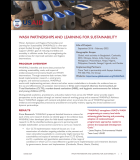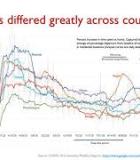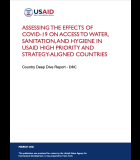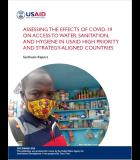Integrated Health Project (IHP)
The five-year IHP supported the DRC’s National Health Development Plan (Plan National de Développement Sanitaire (PNDS), MSP, 2011–2015). The IHP’s main goal was to improve the enabling environment for and increase the availability and use of high-impact services, products, and practices for family planning (FP), maternal, newborn, and child health (MNCH), nutrition, malaria, and tuberculosis (TB), Human Immunodeficiency Virus (HIV) and Acquired Immunodeficiency Syndrome (AIDS), and water, sanitation, and hygiene (WASH) in target health zones (HZs).
IHP had two components: Component 1 corresponded to the first strategic focus of the DRC’s PNDS, which is to strengthen the HZs’ capacity to deliver high-impact services and products by addressing both the supply and demand sides of services; Component 2 corresponded to creating an enabling environment for strong HZs, with particular emphasis on leadership and governance and the provision of resources.
IHP worked in four of the DRC’s original 11 (now 26) provinces: Kasaï Occidental, Kasaï Oriental, Katanga,2 and South Kivu. IHP partnered with the MSP, many bilateral and multinational donors, faith-based organizations (FBOs), and non-governmental organizations (NGOs) to implement MPA-/ CPA-plus. It also provided technical assistance for specialized health systems, strengthening interventions at all levels. IHP established eight provincial level coordination offices, or Bureaux de Coordination (BCs), to facilitate project implementation at HZs and the assisted health facilities’ level (i.e., Health Centers (HCs) and General Referral Hospitals (GRHs.)) The project worked in 78 target HZs3 and provided varying levels of support to 1,476 facilities (1,398 HCs and 78 GRHs). HIV and AIDS activities were implemented in Katanga province. WASH activities were concentrated in nine HZs instead of the original 80 assisted HZs.
Activity Description
DRC-IHP worked closely with the DRC Government to strengthen the country’s health system at every level. Part of the project’s comprehensive approach to health was a focus on improving water, sanitation, and hygiene (WASH) as well as nutrition in which infant and young child feeding activities emphasized WASH. The project also targeted maternal, newborn, and child health; family planning; and malaria, tuberculosis, and HIV/AIDS.
Under the Village Assaini approach, communities will be empowered to claim their rights while the local government takes ownership of the process. Once a contract between the community and local government is signed, the community members participate in interactive processes through which they identify their own problems and formalize an action plan to take steps to improve their water, sanitation, and hygiene conditions. They then work with the WASH partners to construct water and sanitation infrastructure and to take part in participatory training to encourage improved WASH behaviors. To build capacity and to ensure the technical and financial sustainability of infrastructure improvements, training on pump operation and maintenance is organized. Once construction has been completed and a village has been declared “healthy,” maintenance will become the responsibility of the village and health zone.
Expected Outcomes
- Access to and availability of minimum package of activities plus/complementary package of activities plus (MPA-plus/CPA-plus) services in target HZs increased
- Quality of MPA-plus/CPA-plus services in target HZs increased
- Knowledge, attitudes, and practices (KAP) to support health-seeking behaviors increased in target HZs.
- Health sector leadership and governance in target provinces improved
Actual Outcomes
- Over 332,934 people gained first time access to improved drinking water.
- Over 332,854 persons gained first time access to improved sanitation facilities.
- USAID beneficiaries disinfected 180,098,710 liters of water with point-of-use water treatment products.






